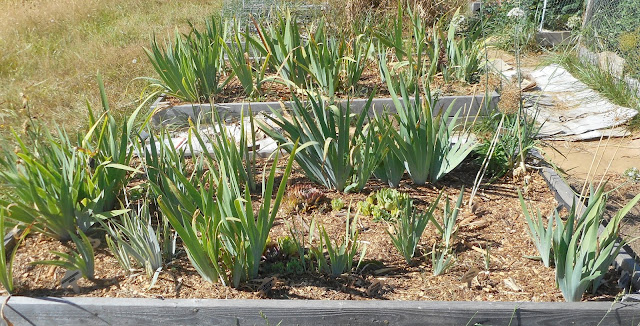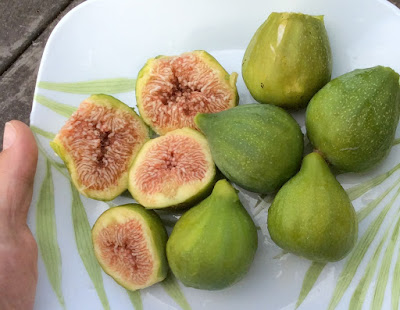 |
| Daylilies from Oakes Daylilies. 7.11.15 |
This seems to be my year of the daylily. One night, 10days ago, I could not sleep. I googled on daylilies, and wound up on the page for
Oakes Daylilies in Tennessee.
I ordered the following varieties:
Strawberry Candy - 26" tall, 4 1/4" flower, strawberry red, rose red eye zone. Reblooms. Semi-evergreen, tetraploid, 1989.
Carefree Peach - 27" tall, 3" flower, peach color, narrow rose red eyezone, starts early and blooms until frost. Diploid, dormant,
Siloam Virginia Hansen - 18" tall, 4" flower, pale pink, red eye, green throat. Not listed as reblooming. Diploid, dormant, 1979.
They added a bonus variety,
Winsome Lady. 24" tall, 5 1/2" pink flower, early starter with rebloom, fragrant. Diploid, dormant, 1964.
These seem like a nice selection. They do not duplicate varieties that I already have. I am going to count on them not being different from pictured in the catalog. The catalog is copyrighted, so I won't post their photos here.
 |
| Planted Carefree Peach. 7.11.15 |
These are very impressive daylily clumps. These are fat clumps, with healthy looking thick roots, big clumps with multiple fans. They are far, far, better than what I have seen locally in containers. Most will probably not bloom until summer 2016, so you don't get the instant gratification. I don't need instant gratification. It's possible I might see flowers on the rebloomers in the group.
Today was quite overcast, and temp only into low 80s. They should do OK. Of the varieties, Carefree Peach was more like a cluster of 5 separate plants, so I planted them slightly apart to give growing room. All of the others were single clumps, which I did not attempt to divide.
Adding some info on other varieties in my border-
Chicago Apache. 27" tall, 5" flower, tetraploid, dormant. 1981. Not listed as rebloomer, and has not rebloomed for me.
 |
| Chicago Apache. 7.11.15 |
Pardon Me. 18" tall. 2 3/4" flowers. Diploid, Rebloom. Fragrant. AHS states nocturnal bloomer - if that means it only blooms at night, I may not keep it. According to AHS, nocturnals open in the evening, and my be open for the next day.
Fooled Me. 24" tall, 5.5" flower , Dormant, tetraploid, extended blooming season,
Stella D'Oro. Kind of a cliche variety, seen everywhere. 1975. Diploid, dormant. Extended blooming / reblooming.
Luxury Lace. 32", 4.5" flower, reblooms, diploid, dormant. 1959.
Ice Carnival, 28" tall, 6" flower size, mid season with reblooms. diploid, dormant. 196. Listed as very fragrant. I've had it for 3 years and was not aware of fragrance.
There are also some mystery varieties, and some that are clearly not what was on the label, possibly mutants of known varieties.
Much of the variety details above comes from the
AHS website, or Oakes Daylily, or general web search.
Hybridizing.
Today I also played with them a little. I added pollen from Chicago Apache (triploid) to Fooled Me (triploid) an the unknown that is either mislabeled or mutant Daring Deception. I added pollen from Fooled Me to Chicago Apache. I also added self-pollen to stamens of Ice Carnival, and to an unknown somewhat ruffle yellow. Diploid will not pollinate triploid, and triploid will not pollinate diploid.
































